In the era of analogue consoles, the functionality of a channel was defined by physical controls—knobs and buttons—whose layout was immediately intelligible, yet also imposed a fixed framework of operation. In the digital age, mixing consoles, equipped with robust processing power and a flexible architecture, have fundamentally redefined the concept of a “channel”. Input and output channels (or buses) are no longer mere signal paths; they constitute a highly integrated, freely configurable audio processing network.
A thorough understanding of these two core components is essential to mastering any digital mixing console, from basic reinforcement to complex production workflows. This article, using the S-Track HIPPO D2412 digital mixer as a reference, systematically examines the technical architecture of digital console channels.

Section 1: Input Channels — The Signal Conditioning Pathway
The input channel serves as the initial stage for signals entering the console. Its primary role is to amplify, shape, and route low-level signals from microphones and instruments towards their intended destinations. It comprises a comprehensive audio processing chain, typically consisting of the following key elements:
Compressor/Limiter (COMP): Present on every output channel of the HIPPO D2412, this function prevents excessive signal levels from causing distortion in downstream equipment (such as power amplifiers and loudspeakers), thereby ensuring system integrity and safe operation.
Practical implication: Failure to deploy compression appropriately can result in a loss of dynamic responsiveness. Excessively high output levels lead to harsh, muddied reproduction and potential hardware damage.

GEQ/PEQ (Equalisation): Available across output channels, including graphic and parametric equalisers, these tools adjust system frequency response. They serve to flatten overall response, enhance fidelity, and mitigate microphone feedback. In practice, GEQ and PEQ may be used independently or in combination to suit acoustic and artistic requirements.


Delay: A critical feature within output channels, delay alignment compensates for temporal discrepancies between different loudspeaker systems. For instance, full-range systems, subwoofers, and fill speakers—each connected to distinct outputs (e.g., Main, Mix 1, Grp 1)—may be synchronised using the console’s integrated delay functionality, obviating the need for external processors.


Polarity: Polarity inversion adjusts the phase relationship between loudspeakers, ensuring coherent summation and improved sonic clarity.

Section 2: Output Channels — The Signal Mixing and Distribution Hub
Output channels aggregate signals from input channels, effects-returns, and other sources, mix them, apply final processing, and route the result to amplifiers or recording devices. They too form a complete processing chain, incorporating functions such as:
Gain: Adjusts input signal level, functioning as an initial volume control.
Pad: Applies fixed attenuation (e.g., 10 dB or 20 dB) where input signals are excessively high, serving as a pre-gain reduction tool.
Trim: A feature specific to digital consoles, Trim adjusts the level of signals after analogue-to-digital conversion, or of digital inputs received via network or USB interfaces. Whilst Gain controls analogue input levels, Trim operates in the digital domain. Typically, Trim is set to 0 dB under normal conditions.

Polarity (Phase Inversion): Inverts the input signal phase by 180 degrees to correct phase cancellations—e.g., between top and bottom snare microphones, or to minimize feedback between adjacent microphones through alternating polarity assignments.
+48V Phantom Power: Supplies power to condenser microphones, essential for their operation.
Delay: Introduces time alignment between audio sources—e.g., reconciling phase issues in multi-mic drum recordings—or creating depth effects during post-production.
Gate: Attenuates unwanted noise or spill, preserving source clarity.

Four-Band PEQ: Provides detailed tonal shaping for source optimization.

HPF (High-Pass Filter): Removes low-frequency content below a user-defined point, reducing rumble and extraneous low-end energy.
Compressor/Limiter: When configured as a limiter, it protects against input overload and subsequent distortion; as a compressor, it dynamically controls dynamic range for instruments such as drums and bass.

Conclusion
A methodical understanding and proficient application of input and output channel functions facilitate the transition from mere sound operation to deliberate sound craft. Whether in live reinforcement or studio production, mastery of these tools unlocks the full potential of digital mixing consoles, enabling the creation of clear, powerful, and engaging audio.
We hope this technical overview has enhanced your understanding of digital mixing console architecture. For further product information, please visit www.s-track.com.cn or contact our support team.
400-900-2726
9th Floor, 1B, Shangzhi Technology Park, Guangming District, Shenzhen City, Guangdong Province, China
Copyright © SHENZHEN S TRACK SCIENCE TECHNOLOGY CO., LTD